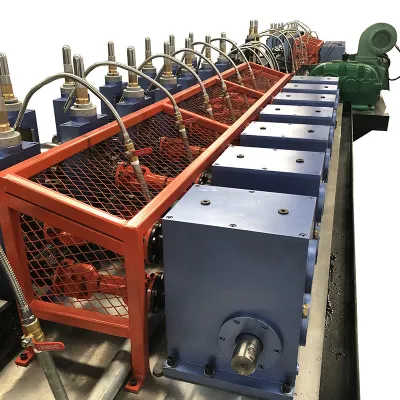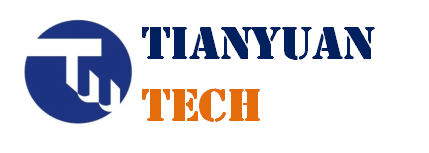Core Components and Technology of ERW Pipe Mills
Essential Machinery in ERW Production
To really get how ERW production works, one needs to understand what makes it tick at the machine level. Three main pieces of equipment stand out in this process: the decoiler, forming mill, and sizing mill, each playing its own role in the manufacturing chain. Starting things off, the decoiler takes care of unrolling those long steel strips that will eventually become pipes. What follows next is pretty fascinating—the forming mill does all the heavy lifting when it comes to shaping those flat strips into round pipes through continuous bending operations. This shaping stage is actually critical for getting the right structural integrity in the finished product. After that comes the sizing mill which acts like a finishing touch, tweaking the dimensions so every pipe meets strict specifications. These days, precision matters more than ever because technological advancements have completely changed how efficient and high quality our steel pipes can be. Take CNC technology for instance; it's revolutionized operations on factory floors everywhere. With these computer controlled systems, manufacturers can produce pipes faster while making fewer mistakes, all without sacrificing the quality standards customers expect from their steel products.
High-Frequency Welding Process
In ERW pipe manufacturing, high frequency welding makes good use of electromagnetic energy to join metals together, creating almost seamless welds without needing much extra effort. Compared to older welding techniques, this method works much quicker and saves on resources too. Industrial reports keep showing just how much time and money companies can save when they switch to these modern systems, which really boosts factory output. The stronger, longer lasting pipes produced through this process are especially important for keeping things safe across different industries like building construction and oil transportation. Manufacturers love that these welds form solid continuous lines throughout the pipe, meaning fewer leaks down the road and safer operations overall for whoever ends up using them.
Material Versatility: Stainless Steel to GI Pipes
ERW pipe production works with all sorts of materials, stainless steel being one of the main ones along with galvanized iron or GI pipes. Stainless steel stands out because it doesn't rust easily, which makes it great for places where there's lots of water around or chemicals present. The stuff gets used everywhere from food processing plants to coastal areas where salt air would eat away at regular metal. GI pipes on the other hand cost way less money, so they tend to show up in construction projects where budgets are tight but still need decent quality piping. We've seen over recent years that customers want both green options and good value for their money, which explains why companies keep developing new combinations of materials. When manufacturers really get what makes each material tick, they can create products that fit different needs across countless industries, whether it's running water through homes or handling harsh industrial fluids.
Advantages Driving ERW Pipe Mill Adoption
Cost-Effective Manufacturing Solutions
ERW pipe mills offer some serious cost advantages because they streamline operations using automated systems throughout the production line. Compared to traditional seamless or welded approaches, these mills slash production expenses thanks to better tech integration and smarter workflow management. Many manufacturers have seen dramatic improvements after switching to ERW methods, cutting down on scrap metal and reducing the need for manual labor across their facilities. The bottom line? Lower overhead costs that stick around even when market prices fluctuate wildly. That's why so many plant managers keep coming back to ERW solutions despite what's happening in commodity markets.
Superior Structural Integrity
ERW pipes stand out for their solid construction, with impressive tensile strength that makes them resistant to bending or deforming when stressed. These pipes pass all the major industry tests set by groups like ASTM and API, which is why they work so well for transporting oil and gas through pipelines where pressure matters a lot. Throughout manufacturing, various testing procedures check each pipe to make sure it meets what's needed for the job. What really counts though is how these pipes hold up over time in real world conditions. They can handle serious pressure without breaking down, which explains why many companies rely on them for critical infrastructure projects across different industries.
Adaptability Across Industrial Sectors
ERW pipes work really well in all sorts of industries, everything from building sites to car factories, which makes them pretty important when companies plan their production lines because they can bend and shape so easily. Each industry wants something slightly different, but ERW technology keeps up with most of these needs pretty well. Take cars for instance automotive companies use these pipes in exhaust systems since they're strong yet light enough not to weigh down vehicles too much. Construction workers also rely on ERW pipes for foundations where solid support matters a lot. The fact that one type of pipe can handle such varied applications speaks volumes about why manufacturers keep turning to ERW solutions time after time.
Key Industrial Applications of ERW Pipe Mills
Oil and Gas Pipeline Systems
ERW pipes are essential components in building oil and gas pipelines because they offer exceptional strength, last longer than alternatives, and come with built-in safety characteristics. What makes these pipes stand out is their capacity to handle extreme pressures and survive tough conditions, which explains why they're so commonly used when moving crude oil and natural gas over long distances through various terrains. According to recent market analysis, we're seeing steady growth in infrastructure projects across the oil and gas industry, which naturally drives up the need for dependable ERW pipe solutions. Plus, these pipes pass all the strict regulatory checks required for installation in dangerous areas, giving operators peace of mind about both worker safety and operational efficiency on site.
Construction and Urban Infrastructure
ERW pipes play a vital role in construction projects across cities, especially when it comes to building essential infrastructure such as water distribution networks and sewage systems. These pipes last longer because they're built tough, which means lower maintenance expenses down the road and fewer headaches from needing constant repairs or full replacements. With cities expanding at breakneck speed around the world, construction companies are scrambling to get their hands on enough ERW pipes. The simple truth is that modern urban areas just can't function without these durable steel products supporting all sorts of critical underground systems that keep millions of people connected to clean water and proper sanitation facilities.
Automotive and Transportation Sector
Electric resistance welded (ERW) pipes play a major role in car manufacturing, especially when it comes to building frames and exhaust systems. Car makers need parts that are light but still strong enough to handle road conditions, and ERW pipes check both boxes. The whole auto industry has been going crazy about lighter materials lately because they help cars burn less gas. ERW technology actually works really well with what manufacturers are trying to achieve here. Most plants have started incorporating these pipes into their production lines as part of broader efforts to meet stricter emissions standards while keeping vehicles durable enough for everyday driving.
Water Management and Distribution Networks
Water systems across the country depend on ERW pipes for transporting fluids throughout distribution networks and treatment plants because they just work better than alternatives. When it comes to making infrastructure greener, these pipes help conserve water since they last longer and don't leak as much as other materials do over time. Municipalities report losing millions of gallons annually from old pipe systems, so switching to ERW makes good sense both economically and environmentally. The reduced maintenance needs combined with lower leakage rates mean communities get consistent access to clean drinking water without constant interruptions or costly repairs down the road.

Technological Innovations in ERW Manufacturing
Automation and Precision Engineering
Automation is changing how ERW pipe mills operate, boosting their efficiency across the board. Robotics and artificial intelligence systems have really shaken up old school manufacturing methods, cutting down on waste while speeding things up considerably. When it comes to precision engineering, these advanced techniques matter a lot for pipe quality control. The better the engineering specs, the fewer defects we see in final products, which means customers get consistent results every time they order from these mills. Some manufacturers report defect rates dropping by over 30% after implementing smart automation solutions.
Automation Benefits: By employing automation, pipe mills can significantly reduce labor costs and increase production throughput, leading to higher efficiency and profitability.
Precision Techniques: Advances in precision engineering ensure that pipes are manufactured with exact specifications, ensuring quality and reducing waste.
Expert Insights: Industry experts often highlight automation as a key driver in lowering labor costs while boosting production rates, which is vital for competitiveness.
Advanced Coating and Corrosion Resistance
The evolution of coating technologies has become a cornerstone in ERW pipe manufacturing, particularly addressing corrosion resistance. These advancements involve using high-performance materials that extend the longevity of pipes in aggressive environments.
Material Advancements: Recent innovations have introduced new materials that offer superior protection against corrosion, essential for applications in harsh settings.
Case Studies: Numerous studies show how improved coatings contribute to pipes' durability, exemplifying real-world success in challenging environments.
Regulatory Compliance: Meeting stringent regulatory requirements ensures market acceptance and broad application of these advanced coatings.
These developments reinforce the reliability and sustainability of ERW pipes in various industrial applications, ensuring they remain a preferred choice where durability and longevity are critical.
Global Market Trends and Future Projections
Growing Demand in Emerging Economies
Electric Resistance Welded (ERW) pipe demand is on the rise across emerging economies, mainly because of all the infrastructure work and cities expanding so fast right now. The Asia Pacific area, especially places like India and China, looks set to drive most of this growth thanks to lots of government backed construction projects happening there. Market research suggests that growth rates in this region could hit around 6.2 percent year over year, which sounds pretty good when we look at things. Meanwhile down in Latin America, similar trends are showing up too, with energy sector developments and building activity pushing forward. For companies wanting to get into these markets, it makes sense to adjust their offerings according to what local regulations require and find ways to produce efficiently without breaking the bank. Getting familiar with regional specifics seems crucial for anyone serious about establishing themselves in these rapidly growing areas.
Sustainability in Steel Pipe Production
Making sustainability part of ERW pipe manufacturing is no longer optional for most companies these days. Many producers are now going green by cutting down on waste and finding better ways to source their raw materials. Take the EU for instance their strict rules force steelmakers to produce lower carbon steel while using more recycled content in their products. Some factories have started implementing new recycling techniques that cut down on scrap metal waste. Others are experimenting with alternative fuels that burn cleaner than traditional coal. These changes aren't just good for the planet they also help reduce long term costs as energy prices continue to rise across Europe.
FAQ
What is ERW in pipe manufacturing?
ERW stands for Electric Resistance Welded pipes, a key method in producing pipes with strong structural integrity.
Why is high-frequency welding important?
High-frequency welding is essential because it ensures a seamless bond and increased durability in pipes.
What materials are most commonly used in ERW pipes?
Stainless steel and galvanized iron are common materials used in ERW pipes due to their corrosion resistance and affordability.
How do ERW pipes benefit the oil and gas industry?
ERW pipes benefit the oil and gas industry by providing durability and strength necessary for high-pressure applications.
What trends are influencing the future of ERW pipe production?
Emerging economies and sustainability practices are major trends influencing the future of ERW pipe production.

